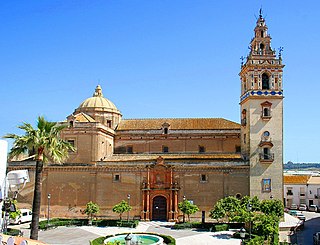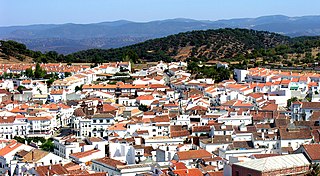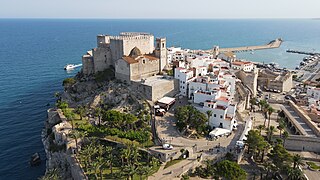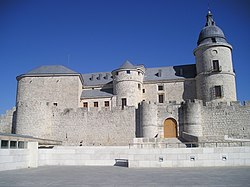
Simancas is a town and municipality of central Spain, located in the province of Valladolid, part of the autonomous community of Castile and León. It is situated approximately 10 km southwest of the provincial capital Valladolid, on the road to Zamora and the right bank of the river Pisuerga.

The Castle of Púbol or Gala Dalí Castle House-Museum, located in Púbol in the comarca of Baix Empordà, Girona, Catalonia, Spain, is a medieval building where the surrealist painter Salvador Dalí's enormous creative efforts were focused on a single person, his wife Gala, with the aim of providing her with a unique sanctuary and resting place. Gala is buried at the castle. Together with the Salvador Dalí House Museum in Portlligat and the Dalí Theater-Museum in Figueres, they form the Empordà Dalinian triangle.

Arcos de la Frontera is a town and municipality in the Sierra de Cádiz comarca, province of Cádiz, in Andalusia, Spain. It is located on the northern, western and southern banks of the Guadalete river, which flows around three sides of the city under towering vertical cliffs, to Jerez and on to the Bay of Cádiz. The town commands a fine vista atop a sandstone ridge, from which the peak of San Cristóbal and the Guadalete Valley can be seen. The town gained its name by being the frontier of Spain's 13th-century battle with the Moors.

Moguer is a municipality and small city located in the province of Huelva, Andalusia, Spain. According to the 2022 census, it has a population of 22,623. Its surface area is 204 square kilometres (79 sq mi), and its population density is 106.36 per square kilometre (275.5/sq mi).

Aracena is a town and municipality located in the province of Huelva, southwestern Spain. As of 2012, the city has a population of 7,814 inhabitants. The town derived its name from the Sierra de Aracena, which is part of the Sierra Morena system.

The Alcazaba is a palatial fortification in Málaga, Spain, built during the period of Muslim-ruled Al-Andalus. The current complex was begun in the 11th century and was modified or rebuilt multiple times up to the 14th century. It is one of the best-preserved alcazabas in Spain. The Alcazaba is also connected by a walled corridor to the higher Castle of Gibralfaro, and adjacent to the entrance of the Alcazaba are remnants of a Roman theatre dating to the 1st century AD.

The Alcazar of Segovia is a medieval castle located in the city of Segovia, in Castile and León, Spain. It has existed since at least the 12th century, and is one of the most renowned medieval castles globally and one of the most visited landmarks in Spain. It has been the backdrop for significant historical events and has been home to twenty-two kings, along with notable historical figures.

Ciudad Colonial is the historic central neighborhood of the Dominican Republic's capital Santo Domingo. It is the oldest continuously inhabited European-established settlement in the Americas. The area has been declared a World Heritage Site by UNESCO. It is also known as Zona Colonial or more colloquially as "La Zona".

Sos del Rey Católico is a historic town and municipality in the Cinco Villas comarca, province of Zaragoza, in Aragon, Spain.

The National Archives of Chile is a public organization of the Chilean state, created in 1927 with the goal to "collect and conserve the archives of the Departments of State and all the documents and manucsrpits related to the national history, and to oversee their organization and use". It is treated as a dependent organization of the Dirección de Bibliotecas, Archivos y Museos, which is administered by the Consejo Nacional de la Cultura y las Artes de Chile.

The General Archive of Simancas is an official archive located in the Castle of Simancas, in the town of Simancas, province of Valladolid, Castile and León, Spain. It was founded in 1540, making this the first official archive of the Crown of Castile.

The Cathedral of Málaga is a Roman Catholic church in the city of Málaga in Andalusia in southern Spain. It is in the Renaissance architectural tradition. The cathedral is located within the limits defined by a now missing portion of the medieval Moorish walls, the remains of which surround the nearby Alcazaba and the Castle of Gibralfaro. It was constructed between 1528 and 1782, following the plans drawn by Diego de Siloe; its interior is also in Renaissance style.

The Lugares colombinos is a tourist route in the Spanish province Huelva, which includes several places that have special relevance to the preparation and realization of the first voyage of Cristopher Columbus. That voyage is widely considered to constitute the discovery of the Americas by Europeans. It was declared a conjunto histórico artístico by a Spanish law of 1967.

The General Archive of the Crown of Aragon, originally Royal Archives of Barcelona, is an archive containing the background documents of the institutions of the former Crown of Aragon and currently also contains other historical resources.

The National Historical Archive of Spain is based in Serrano Street in Madrid. It was founded in the nineteenth century when it shared a building with the Real Academía de la Historia.

Santa María de la Cabeza castle is a colonial castle built in the seventeenth century by the Spanish monarchy in the center of the city of Cumaná, Venezuela. It was built as a replacement for the San Antonio de la Eminencia castle. Its construction was ordered by Sancho Fernando de Angulo y Sandoval, governor of the Province of Cumaná. The building was designed using the trace italienne style popular during the seventeenth century, with a proportional geometric floor design. Bastions were used as the main defensive elements. The castle housed a garrison of 250 soldiers, and was the seat of government for the Province of Cumaná.

Hacienda Chenché de las Torres is located in the Temax Municipality in the state of Yucatán in southeastern Mexico. It is one of the properties that arose during the nineteenth century henequen boom, and was owned by Álvaro Peón de Regil y Joaquina Peón Castellanos, the Count and Countess of Miraflores.

The Castle of Coca is a castle located in the Coca municipality, central Spain. The castle was constructed in the 15th century and has been considered to be one of the best examples of Spanish Mudejar brickwork which incorporates Moorish Muslim design and construction with Gothic architecture. A scale model of the castle has been built in the Mudéjar theme park and another replica built at a ratio of 1:25 is placed in the Minimundus miniature park in Klagenfurt, Austria.

Peniscola Castle is a castle in Peniscola, Castellón, Valencian Community, Spain. The castle is restored and is open to the public.





















